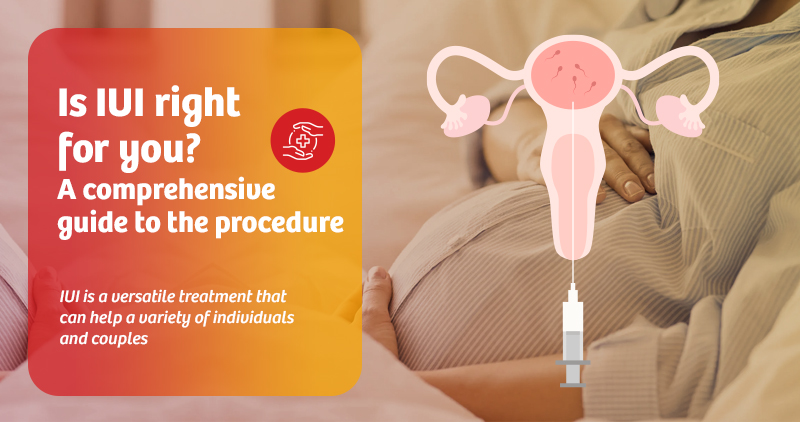If you are exploring fertility treatments, you may have come across Intrauterine Insemination (IUI) as a potential option. Whether you are just starting your journey or looking for alternatives to more invasive procedures, this guide will walk you through everything you need to know about IUI—what it is, who it is for, the process, success rates, and more.
What is IUI?
Intrauterine Insemination (IUI) is a fertility treatment that involves placing washed and concentrated sperm directly into the uterus during ovulation. It increases the chances of sperm reaching the egg, making it a popular option for couples and individuals facing fertility challenges. Unlike IVF (In Vitro Fertilisation), IUI is less invasive, more affordable, and often used as a first-line treatment.
Who is IUI for?
IUI is a versatile treatment that can help a variety of individuals and couples, including:
- Couples with unexplained infertility: When tests don't reveal a clear cause for infertility, IUI can be a good starting point.
- Mild male factor infertility: If the male partner has a low sperm count or reduced sperm motility, IUI can help by concentrating healthy sperm.
- Women with cervical mucus issues: The cervix may produce mucus that hinders sperm movement, which IUI bypasses.
- Those seeking a less invasive option: IUI is less complex and less expensive than IVF, making it an attractive choice for many.
The IUI process: Step-by-step
The IUI process is straightforward and typically involves the following
steps:
- Ovarian stimulation (Optional):Some women take fertility medications like Clomid or Letrozole to stimulate the ovaries and produce multiple eggs. This step is optional and depends on your specific situation.
- Monitoring ovulation:Your doctor will monitor your cycle using ultrasounds or ovulation predictor kits to determine the best time for the procedure.
- Sperm preparation:On the day of the procedure, the sperm sample (from a partner or donor) is processed in the lab to remove impurities and concentrate the healthiest sperm.
- The IUI procedure:A thin catheter is used to insert the prepared sperm directly into the uterus. The process is quick, painless, and similar to a pap smear.
- The two-week wait:After the procedure, you’ll wait about two weeks before taking a pregnancy test to see if the IUI was successful.
Success rates of IUI
The success of IUI depends on several factors, including age, the cause of infertility, and sperm quality. On average:
- Women under 35 have a 10-20% success rate per cycle.
- Success rates decrease with age, dropping to around 5-10% for women over 40.
It’s important to note that multiple IUI cycles may be needed to achieve pregnancy. Your doctor can help you understand your specific chances based on your unique situation.
Benefits of IUI
Like any fertility treatment, IUI has its advantages and disadvantages:
- Less invasive: No surgery or egg retrieval is required.
- More affordable: IUI is significantly cheaper than IVF.
- Minimal discomfort: The procedure is quick and relatively painless.
- Can be combined with medications: Fertility drugs can improve your chances of success.
What to expect after IUI
After the procedure, you may experience mild cramping or spotting, but these symptoms are usually short-lived. The two-week wait can be emotionally challenging, so it’s important to stay positive and distract yourself. When it’s time to take a pregnancy test, your doctor will guide you on the next steps, regardless of whether the result is positive or negative.
Tips for preparing for IUI
To maximise your chances of success, consider the following tips:
- Maintain a healthy lifestyle: Eat a balanced diet, exercise regularly, and manage stress.
- Avoid harmful habits: Quit smoking, limit alcohol, and reduce caffeine intake.
- Stay informed: Ask your doctor questions and understand the process.
- Lean on support: Share your journey with loved ones or join a support group for emotional encouragement.
Alternatives to IUI
While IUI is a great option for many, it’s not the right choice for everyone. If IUI isn’t successful or suitable for your situation, other fertility treatments include:
- IVF (In Vitro Fertilization): Eggs are retrieved and fertilized in a lab before being transferred to the uterus.
- ICSI (Intracytoplasmic Sperm Injection): A single sperm is injected directly into an egg, often used for severe male infertility.
- Natural conception options: Lifestyle changes, ovulation tracking, or fertility medications may help in some cases.
In a nutshell:
IUI is a promising fertility treatment that has helped countless individuals and couples achieve their dream of parenthood. While it’s not a guaranteed solution, its affordability and less invasive nature make it an excellent first step for many. If you’re considering IUI, consult a fertility specialist to determine if it’s the right option for you. Remember, every journey is unique, and there’s hope at every step. At KD Blossom, we have dedicated and experienced team of IVF specialists with the state-of-the-art facilities related to IUI and IVF procedures.
FAQs about IUI
- Is IUI painful?
Most women feel minimal discomfort during the procedure, but mild cramping may occur.
- How many IUI cycles should I try?
Many doctors recommend 3-6 cycles before considering other options, but this depends on your circumstances.
- Can IUI work for older women?
Success rates decline with age, but IUI can still be an option for women in their late 30s or early 40s.

